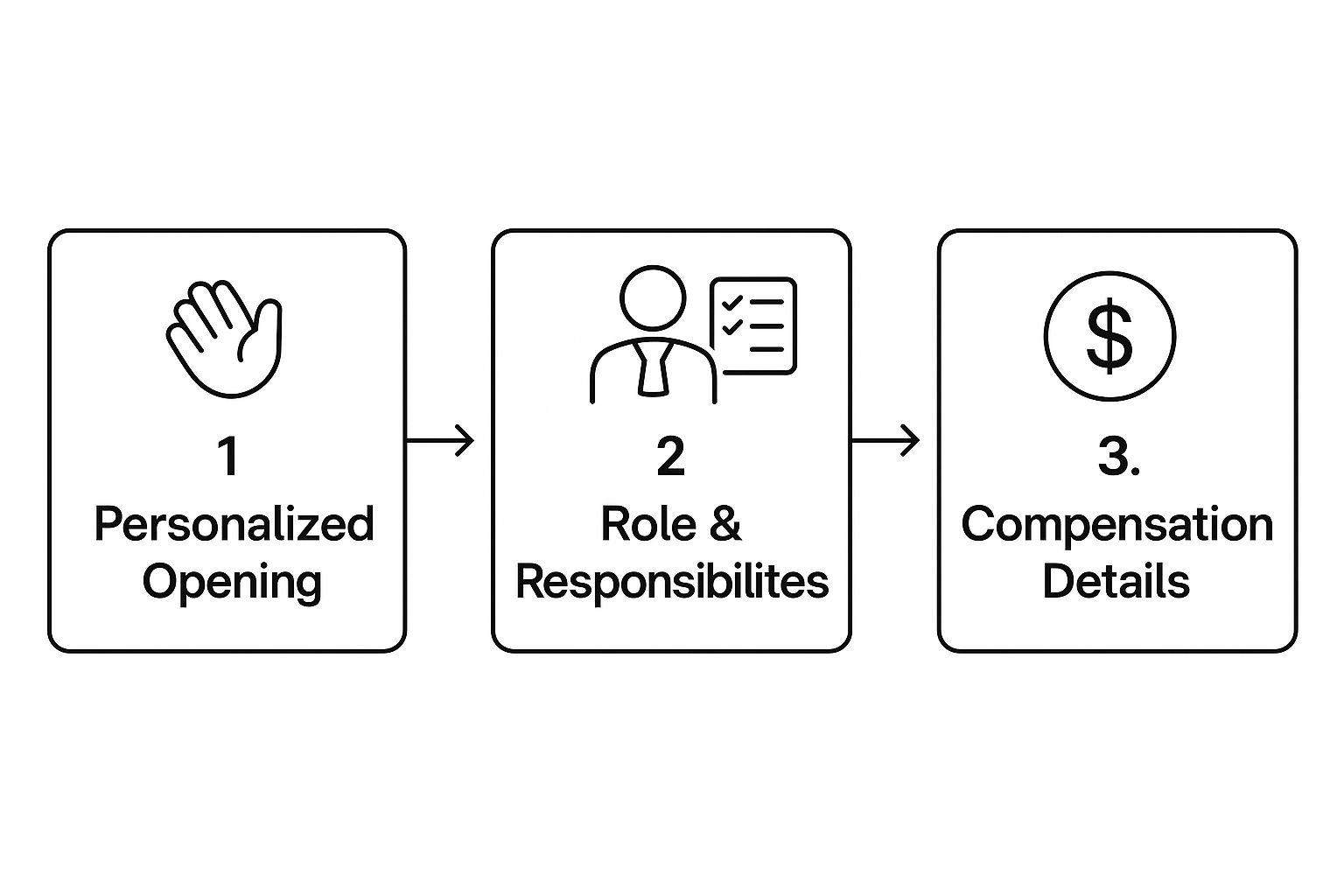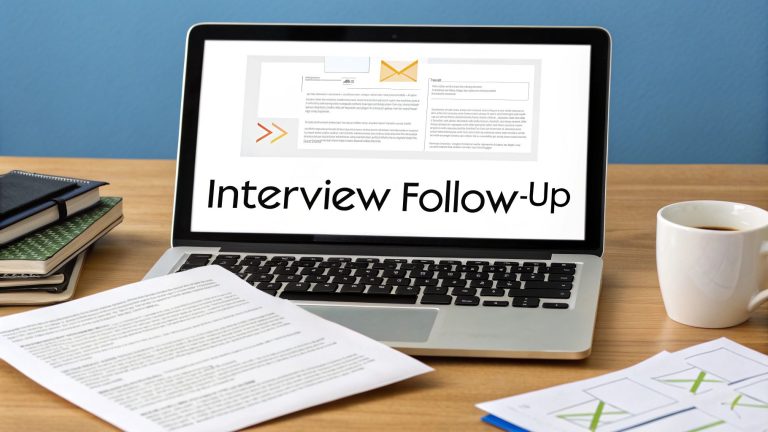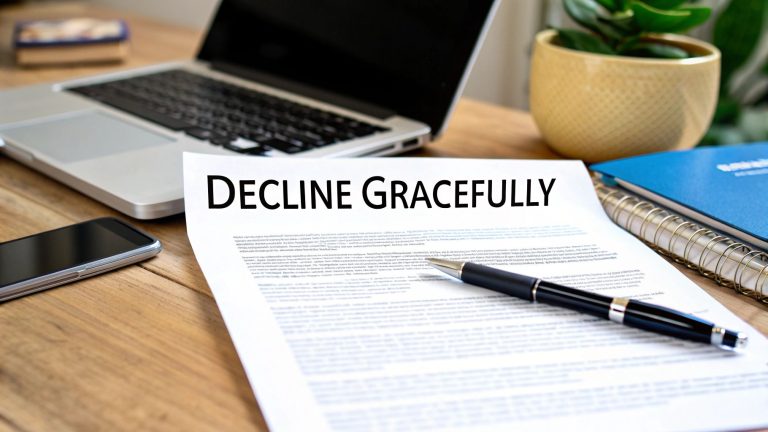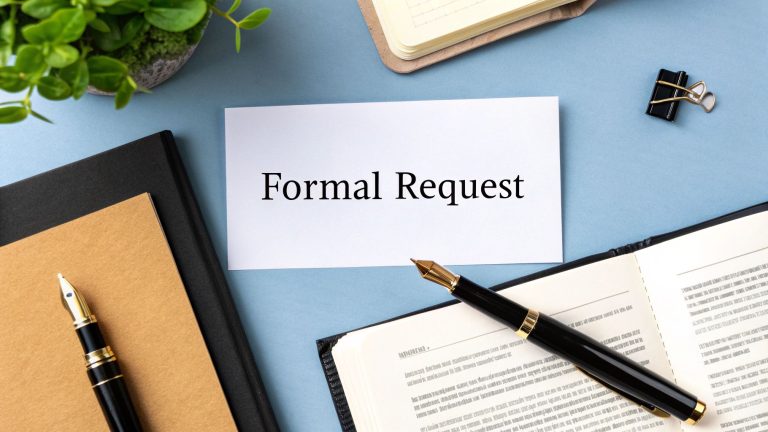A promotion offer letter is more than just a template; it's the official announcement that moves a verbal agreement into a formal, documented record. It’s your chance to detail an employee’s new role, responsibilities, and compensation, protecting both them and the company. Using a well-crafted format ensures you don't miss a single critical piece of information.
Why a Great Promotion Letter Matters More Than You Think

It’s easy to see a promotion offer as just another administrative task on your to-do list. But staring at that blank document is about more than just filling in fields—you're crafting a pivotal career moment for a valued team member.
Think of it this way: a well-written promotion letter is your first and best tool for retaining that employee in their new position. It’s the culmination of all their hard work and dedication. A vague or unenthusiastic letter can instantly deflate their excitement and sow seeds of doubt.
On the other hand, a clear, thoughtful letter validates their contributions and sends a powerful message: your organization is invested in their growth. It transforms a routine HR process into a meaningful act of recognition.
Setting the Stage for Success
At its core, the letter’s job is to eliminate ambiguity. It sets crystal-clear expectations from day one by outlining new responsibilities, reporting structures, and, of course, the updated compensation package. This clarity is crucial for preventing future misunderstandings and ensuring a smooth transition. Details discussed verbally are easily forgotten or misinterpreted without it.
And this isn't a rare occurrence. Data from Pave shows that the average annual promotion rate hovers around 14% in the tech industry, with rates for lower-level roles climbing as high as 34%. For high-growth companies, the median rate is even higher at 18.3%, highlighting just how often these critical conversations are happening.
This document is more than a formality; it's a strategic tool. It boosts morale, serves as a legal record, and solidifies the employee's commitment by showing them they have a tangible future at your company.
To make sure your letter hits all the right notes, you need to include a few key components.
Key Components of an Effective Promotion Letter
Here's a quick look at the essential elements your promotion offer letter must include to be clear and comprehensive.
| Component | Why It's Critical |
|---|---|
| Clear Job Title | Immediately confirms the new role and eliminates any confusion. |
| Effective Date | Sets a firm start date for the new responsibilities and pay. |
| Reporting Structure | Clarifies who their new manager will be, which is vital for a smooth transition. |
| Updated Compensation | Details the new salary, bonus potential, and any other pay changes. This is often the most anticipated section. |
| New Responsibilities | Provides a high-level overview of key duties, setting clear expectations from the start. |
| Acceptance Deadline | Gives a clear timeframe for the employee to review and sign the offer. |
By including these elements, you create a document that not only informs but also reassures the employee.
More Than Just an Internal Document
Finally, remember that these letters have a life beyond your internal files. They contain sensitive salary information and formalize career progression. This means they can influence wider industry compensation trends and even become part of an individual's future negotiations, as pointed out in discussions around the sensitive nature of offer letters in HR discussions.
Treating this document with the seriousness it deserves protects your company's professionalism. A great letter doesn't just finalize a promotion; it sets the stage for that employee's continued success and loyalty.
Crafting Your Promotion Offer Letter, Piece by Piece
Alright, let's move from theory to actually putting a promotion letter together. The goal here is to create a document that feels genuinely celebratory but is also crystal clear. You want to leave absolutely no room for misinterpretation. Every single part of this letter has a job to do, from recognizing the employee's hard work to laying out the nuts and bolts of their new role.
A great letter always kicks off with a warm, personal congratulations. Ditch the generic "congratulations on your promotion" and connect the new role directly to their specific achievements. This personal touch makes them feel seen and valued, setting a fantastic tone for everything that follows.
After that warm opening, it's time to get down to the specifics. This is where precision is your best friend.
Defining the New Role and Reporting Lines
First things first: lock in the new job title and the exact date the promotion takes effect. Be specific down to the day—this is crucial for payroll and the official start of their new duties. A simple, direct sentence works best: "Effective Monday, August 18, 2025, your new title will be Senior Marketing Manager."
Next, you need to clarify the reporting structure. Will they have a new manager? Are they moving to a different team? Spell it out. Something like, "In your new role, you will report directly to Jane Doe, our Director of Digital Strategy," eliminates any potential confusion.
It's also a good idea to give a quick, high-level overview of their key responsibilities. This shouldn't be a word-for-word copy of the internal job description. Instead, think of it as a summary of the most important functions, focusing on the strategic side of things.
- Lead our regional content strategy, driving brand awareness and engagement.
- Manage a team of three content specialists, providing mentorship and direction.
- Oversee the quarterly marketing budget for all content-related projects.
This infographic breaks down the essential flow for putting your letter together, making sure all the critical information is there and presented logically.

As you can see, the structure is designed to start with personal recognition before diving into the operational and financial details. It just makes sense.
Getting the Compensation and Benefits Right
Let's be honest—this is the section everyone reads first and most carefully. Any ambiguity here can instantly sour the good news. You need to state the new annual salary in clear, bold numbers and mention the payment frequency (e.g., bi-weekly, monthly).
But don't stop at the salary. Be sure to detail any changes to their bonus structure, stock options, or other benefits. If the promotion comes with a higher bonus target, specify the new percentage and any eligibility rules. If they're getting new perks, like a bigger professional development budget or access to a higher tier of health insurance, list them out.
Think of the promotion letter as the single source of truth. It should anticipate and answer every immediate question the employee might have, from their title to their paycheck.
Transparency is non-negotiable. Research shows that while 97% of people believe promotions should be based on merit, a staggering 41% feel their employers never explain the criteria clearly. A well-written promotion letter helps close that gap by formalizing the decision and showing your commitment to their career growth. For a deeper dive, check out Pave's comprehensive research on promotion rates.
Finally, remember that a clean, professional layout makes the information much easier to digest. If you need a refresher, our guide on how to format a letter has some great tips.
Setting the Right Tone for Your Letter

The numbers and titles in a promotion letter cover the "what," but the tone is where you communicate the "why." How you frame the offer can be the difference between an employee feeling like a valued partner and just another cog in the machine. It’s all about striking that perfect balance between professional and personal.
This letter should feel celebratory and motivational, not like a sterile legal notice. You're trying to convey genuine excitement for their future while also formally outlining the new terms. Think of it less as just sharing information and more as reinforcing their decision to build a career with your company.
From Formal to Inspiring
The most effective promotion letters I've seen always start with genuine recognition. Ditch the generic opening and connect the promotion directly to their specific achievements.
For instance, you could mention a key project they spearheaded or a particular skill they developed that paved the way for this advancement.
A standard, forgettable line might be:
"This promotion is a result of your hard work and dedication."
Now, let’s make it real:
"Your leadership on the Q3 product launch was a game-changer for the team. That initiative and drive are exactly why we’re so excited to promote you to this new role."
See the difference? The second example feels earned. It's personal. It validates their specific contributions and proves that leadership is actually paying attention. This is how you turn a standard letter into a powerful communication tool.
A promotion is a huge milestone in someone's career. Your words should match the weight and excitement of that moment, setting a positive foundation for their new responsibilities.
Language to Use and Avoid
Crafting the right message means being deliberate with your word choice. The goal is to sound supportive and confident in their abilities without falling back on corporate jargon that just feels cold.
Here are a few phrases that help build that motivational tone.
- To celebrate their past success:
- "Your exceptional work on…"
- "We’ve been consistently impressed by your ability to…"
- "This promotion is a direct result of your outstanding contributions to…"
- To express confidence in their future:
- "We are confident you will excel in this new capacity."
- "We look forward to seeing the impact you’ll make as…"
- "This new role is a fantastic opportunity for you to…"
On the flip side, steer clear of overly stiff or vague language. Phrases like "as per our conversation" or "duties as assigned" can feel distant and impersonal. For more tips on maintaining a professional yet approachable voice, our resources on professional letter writing have some great insights.
Ultimately, you want to write a letter that doesn't just inform, but inspires. It should make the employee feel proud of what they've accomplished and genuinely excited about the challenges ahead.
Don't Forget the Fine Print: Key Clauses and Legal Protections
A promotion letter is more than just good news and a new salary—it’s a legal document. Getting the details right isn't about being stuffy or overly formal; it's about making sure everyone is on the same page and protecting both the company and your newly promoted employee from headaches down the road. These clauses are what turn a happy announcement into a solid agreement.
Let's start with a big one: the at-will employment statement. People sometimes get tripped up by this, but it’s standard practice. All it does is confirm that the employment relationship can be ended by either person at any time, for any legal reason. Including it ensures the promotion letter isn't accidentally seen as a promise of employment for a specific length of time.
Protecting Your Company’s Information
Promotions almost always come with access to more sensitive information. Your employee is stepping up, and with that comes a greater level of trust and responsibility. That’s why a confidentiality clause is non-negotiable. It’s a clear, friendly reminder of their duty to keep company secrets—like client lists, financial data, or strategic roadmaps—under wraps.
You can phrase it simply, like:
- "In your new role, you'll be working with confidential company information. By accepting this promotion, you reaffirm your commitment to protecting this information during and after your time with us."
- "This includes all proprietary data, customer information, and internal business strategies you have access to."
Adding this reinforces the trust you're placing in them and sets clear expectations from day one. It’s a must-have for any solid promotion letter.
Why At-Will Employment Still Matters
In most U.S. states, including an at-will statement is just smart business. It’s a simple clause that significantly reduces legal risk.
A good at-will clause is straightforward: "Your employment with [Company Name] continues to be on an 'at-will' basis. This means either you or the company can end the employment relationship at any time, with or without cause. This letter outlines your new role but is not a contract for a fixed term of employment."
This language creates a clear legal boundary, preventing any misinterpretation that the promotion guarantees a job for a set period. Of course, managing these signed documents is crucial. Having a system for finding contracts efficiently in Google Drive can be a real lifesaver when you need to pull up a specific agreement quickly.
It's also interesting to look at the bigger picture. The managerial promotion rate hit a high of 7.3% in 2022 before settling back to the pre-pandemic average of about 6.5%. As you can see from these career advancement trends, things are always in flux. That’s precisely why clear, documented offers are so important—they help manage expectations when company growth ebbs and flows.
Finally, you need to make it official. Every promotion letter should end with a simple acceptance section. Add a line for the employee to sign and date, showing they’ve read, understood, and accepted the new role and all its terms. That signature is what turns the letter into a finalized agreement, giving you a clear record and preventing any "he said, she said" issues later on.
Delivering the Offer for Maximum Impact

You’ve spent time carefully putting together the perfect promotion offer. Now comes the big moment—the delivery. How you present this news is just as crucial as the details in the letter itself. It’s what turns a simple update into a genuine career milestone.
The best way to do this? A face-to-face conversation, either in the office or over a video call. This personal touch lets you share your excitement, see their reaction firsthand, and tackle any immediate questions.
Right after your chat, send over the formal offer letter via email. This combination is powerful: you get the warmth of a personal conversation followed immediately by the official, documented details.
Choosing Your Delivery Channel
An in-person chat is always the gold standard, but we all know the modern workplace demands flexibility. Both in-person and virtual meetings are great options.
- In-Person Meeting: This creates the strongest personal connection. You can celebrate the moment together and have a real, natural conversation. It's the best way to make the experience truly memorable.
- Virtual Call: If your team is remote or hybrid, a video call is the next best thing. You still get that crucial face-to-face interaction that an email just can't provide.
No matter which you choose, the key is to follow up fast. A quick, clear process shows the employee you value them and are invested in their growth.
Don't underestimate the need for speed here. Keeping the momentum going is critical. In fact, data shows that a faster offer stage directly improves acceptance rates. The 2023 trends report from Ashby found that overall offer acceptance rates reached a high of 81% in 2023, proving that a timely delivery makes a huge difference.
Preparing for Their Questions
Once the initial excitement settles, your employee is going to have questions. You need to be ready. They’ll likely ask about their transition plan, new team dynamics, or even how salary negotiations might work.
Come prepared with clear answers about the next steps. Be ready to explain who will announce the promotion, what their onboarding for the new role will look like, and the timeline for their transition.
If they bring up compensation, be open to that conversation. You can even point them to resources like our salary negotiation letter template to help them structure their thoughts. A smooth, thoughtful delivery ensures your newly promoted employee feels supported and set up for success from day one.
Your Ready-to-Use Promotion Offer Letter Template
Alright, theory is great, but a solid template is where the real work gets done. We've taken everything we've talked about—the encouraging tone, the essential clauses, all of it—and poured it into a promotion offer letter template you can start using right away.
This isn't some bare-bones document. It's thoughtfully structured with clear placeholders for all the crucial details: the new title, the official start date, the updated salary and benefits, and who they'll be reporting to. Think of it as your safety net, ensuring you hit every important point with clarity and professionalism.
We've made it available in two popular formats to fit how you work:
- Microsoft Word: Great for those who prefer to work offline or stick to a traditional document process.
- Google Docs: Perfect for collaborating with your HR team or getting quick feedback from managers in real-time.
How to Use the Template
Using the template is simple. Just look for the bracketed text—like [Employee Name] or [New Salary]—and pop in your specific information. I've also peppered in some comments throughout the document to guide you, so you know exactly what to include and why. It's designed to be fast and foolproof.
A great template does more than just save you time. It acts as your final checklist, making sure no critical detail slips through the cracks. It handles the structure, so you can focus on what really matters: celebrating your employee's next step.
Once you’ve personalized the letter for the employee and their new role, it’s ready to go. The aim here is to hand them a document that's not just legally sound but also genuinely exciting, formalizing their promotion and kicking off this new chapter on a high note.
And if you find yourself creating a lot of these letters, our platform might be a lifesaver. Take a look at our free offer letter generator to see how you can create polished, professional documents in just a few minutes. It’s an easy way to keep all your official communications consistent and high-quality.
Common Questions About Promotion Letters
When you're putting together a promotion offer, you’ll find the same questions tend to crop up time and again. Let's walk through a few of the most common ones I hear from managers and HR pros.
One of the first things people ask is, "What's the single most important thing to get right?" While the whole letter matters, if you have to pick one thing, it’s the clear and unambiguous outline of the new compensation package. This means the base salary, any bonus potential, and changes to benefits. Money talk is where ambiguity breeds resentment. Vague financial terms can instantly kill the excitement, so be crystal clear.
In-Person vs. Email Delivery
Another classic debate: should you break the news in person or just send an email? My advice is always the same—do both.
Start with a direct conversation. Whether it's face-to-face or over a video call, sharing the good news personally makes a huge difference. It gives you a chance to see their reaction and answer any questions on the spot.
Then, follow up with the formal letter via email. This approach gives you that personal connection upfront but also provides a written record that the employee can review, sign, and keep for their files.
This two-step process honors the significance of the achievement with a personal touch while ensuring all legal and administrative details are formally documented. It really is the best of both worlds.
How Much Detail Is Too Much?
Finally, I often get asked how deep to go into the new responsibilities. Should the letter be a full-on job description? Absolutely not.
The letter should be a high-level summary of the new role's core functions. Mention the new title and maybe three or four key responsibilities to give them a solid sense of the role without getting bogged down in the weeds. You can always point them to a more detailed job description that you’ll provide separately. This keeps the letter focused on the celebration and the key terms, which is exactly where the focus should be.
Ready to stop staring at a blank page? AI Letter Generator writes polished, professional letters in seconds. Just select your letter type, pick a tone, and let our tool create a perfect draft you can use immediately. Try it for free at lettergenerator.co




